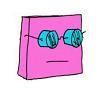"Accomplished by a team at the Huazhong University of Science and Technology and posted 30 minutes ago.
Why this is evidence: The LK-99 flake slightly levitates for both orientations of the magnetic field, meaning it is not simply a magnetized piece of iron or similar ‘magnetic material’. A simple magnetic flake would be attracted to one polarity of the strong magnet, and repelled by the other. A diamagnet would be repelled under either orientation, since it resists and expels all fields regardless of the polarity.
Caveats There is no way to verify the orientation of the strong magnet in this video, also, there are yet to be published experimental measured values of this sample. Diamagnetism is a property of superconductors but without measured and verified data, this is just suggestive of a result.
Take-away If this synthesis was indeed successful, then this material is easy enough to be made by labs other than the original research team. I would watch carefully for results out of Argonne National Lab, who are reported to be working on their own synthesis of a sample.
This overall corroborates two independent simulation studies that investigated the original Korean authors claim about material and crystal structure, and both studies supported the claims.
Lawrence Berkeley National Lab: https://arxiv.org/pdf/2307.16892.pdf Shenyang National Lab: https://arxiv.org/pdf/2307.16040.pdf "
Why can’t an independent researcher just go over to the lab of the original authors with a magnet and some equipment, to verify the measurements on their sample? Why are we forced to squint at blurry Bilibili videos?
Well, what if they’ve painted up some other room temperature superconductor to look like LK-99? Recreating it from scratch avoids that.
some other room temperature superconductor
A what, now? I hope you’re being sarcastic.
You know, just an off the shelf room temperature superconductor that they’ve claimed to synthesize themselves
It’s available from the physics store, right next to point masses and frictionless pulleys.
Still don’t know what a LK-99 is.
It’s an alleged superconducting material that will work at room temperature.
Room temperature and pressure. The two are intrinsically linked.
Can someone explain in lay terms why this is relevant? I read somewhere that it was considered as important as the invention of the transistor but didn’t catch why.
Superconductors in general have no electrical resistance. That’s basically electricity’s friction.
Superconducting materials make the strongest electromagnets, they have big applications in quantum stuff (which I don’t properly understand to try explaining), and they’re used in something called a Tokamak, a specific kind of fusion reactor. They’re useful in anything where electrical resistance is bad in general. When electricity is resisted, we lose some and get heat, so a superconducting wire would lose none and never heat up as a result of resistance.
Superconductors traditionally have to be super freaking cold. A lot of these applications can only be done with liquid nitrogen or even colder things, keeping them superconducting. You can do some things with pressure to help out with that, but the point is it’s not easy to keep a material superconducting. This effort translates to costs, often prohibitive ones, as you need to actively keep these materials from collecting any heat.
If this research pans out, though, this kind of superconductor will just work at standard temperature and pressure. These could go into standard circuits, they can sit around without bleeding money on upkeep, they’re very cool.
People are comparing them to transistors in part because before transistors we had vacuum tubes. Vacuum tubes do the same thing as a transistor, but they’re effectively a lightbulb. They burn out, they produce heat, and they didn’t miniaturize. Transistors were magic at the time because we could do so much more with them than vacuum tubes, and for superconducting metals, this is the same.
Thanks for the explanation. So, this means we are another step closer to quantum computers for example?
I’m trying to grasp on this concept and how we could see this in our daily lives. Better batteries? I thought about that because they get hot when charging but not sure if it’s because of the resistance. Going into standard circuits means we’ll have better SoCs? better integrated circuits? Faster computers or phones?
Im trying to think about a daily life application but maybe it won’t have a direct impact on that area, maybe it’s more about facilitating research that will eventually turn into daily life stuff?
A conductor with no resistance is a big deal for many electrical applications. Electrical resistance is often a big part of design. Removing that aspect changes things significantly. Electrical power losses and the size of conductors can be greatly reduced.
I’ve read lots of unsubstantiated claims about superconductors. A solution has to be producible in quantity at a reasonable cost. Otherwise it’s not going to be a breakthrough. I mean we currently have expensive and bulky superconductor solutions, but they’re limited to applications where it’s reasonable such as MRI machines and particle accelerators.
An inexpensive room temperature superconductor would make the most difference in tech sectors such as power transmission, electromechanical, and power electronics. These are areas where power loss due to circuit resistance is a big part of design. The impact would be minimal for computing and logic. There may be areas where power loss can be reduced, but logic relies on semi-conductors which must have resistance to function, it’s in the name. The term “semi” implies resistance.
Would this potential superconductor work in devices like phones and laptops? Would it lead to more efficient operation?
Would this potential superconductor work in devices like phones and laptops? Would it lead to more efficient operation?
If inexpensive it could be used in power components for consumer electronics like phones and laptops, but wouldn’t make a huge difference since most of the power consumption occurs in chips and displays where superconductors wouldn’t apply. Though it could lead to some reduction in size and better efficiency. Battery operated devices are considered low power. High power applications are where superconductors offer the most benefit.
Holy shit
It’s too good to be true.
Cheap, clean, common doesn’t happen. The odds that they were able to manipulate a second lab to falsify data are a million to one over this being a thing. If I’m wrong I’ll Venmo you twenty bucks, if money is still a thing within weeks of this actually being a thing.
What’s the point in manipulating another lab with money? When confirmations or otherwise will start popping up from other labs around the world in probably days(?)
There’s no such thing as bad publicity, name recognition will get a scientist pretty far.
They have seven days until doubts can truly start cropping up, then another few weeks until all but the people who really want to believe are buying in.
Why would another lab be manipulatable? This guy didn’t even need to get paid off:
“The video in question is allegedly from the University of Science and Technology in Beijing and purports to show a small black substance floating in the air as it follows a magnet. According to the video’s poster, he did it for “attention grabbing purposes” - it was a way to coast the hype around LK-99.” Gotta strike the iron while it’s hot.
Current analysis says lk-99 isn’t even a"good"conductor, let alone a super conductor, let alone a room temperature super conductor. I’ll hope that “this one easy to produce material has revolutionized science” gets discovered some day, but it didn’t happen last week.





